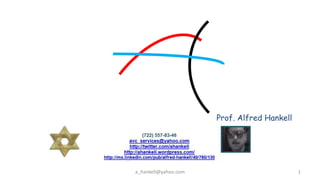
Communication hurdles
- 2. Classes/Coaching on Demand Communication - Social Media - Corporate Culture - Team Building - Diversity Problem Solving – Leadership – Innovation – Creativity - Critical Reasoning Synthesizing – IQ / EQ / CQ - Job Interview – Presentations – Negotiations - TOEFL Prof. Alfred Hankell a_hankell@yahoo.com 2
- 3. Copyright Disclaimer Under Section 107 of the Copyright Act 1976 a_hankell@yahoo.com 3
- 4. •Who are you? •What defines you? •Some lines drawn on your fingertips? •Some switches in your DNA? •Not really. a_hankell@yahoo.com 4
- 5. You are 100,000,000,000 Neurons + Trillions & Trillions of Connections No 2 neurons are the same worldwide. a_hankell@yahoo.com 5
- 6. You are that energy making those connections by using chemicals. That defines YOU. But it also defines the reality that only YOU “see”. a_hankell@yahoo.com 6
- 7. Reality is in the World Without But you “see” the World Within What you “see” is filtered by your neurological connections a_hankell@yahoo.com 7
- 8. Those connections are your World Within Your interpretation of reality And that is the main hurdle for communication. a_hankell@yahoo.com 8
- 9. Check the studies by Lera Boroditsky from the Stanford University among others a_hankell@yahoo.com 9
- 10. a_hankell@yahoo.com 10
- 11. a_hankell@yahoo.com 11
- 12. iStockphoto.com Yes, this is a bridge. Look at it for a moment and ask yourself, "What three descriptive words come into my head when I look at a bridge?" This bridge, or any bridge. (You only get three.) a_hankell@yahoo.com 12
- 13. OK, here's the same bridge. Does it by any chance look: iStockphoto.com a_hankell@yahoo.com 13
- 14. Or, are you more likely to describe it as: iStockphoto.com a_hankell@yahoo.com 14
- 15. The first batch of words — such as beautiful, elegant, slender — were those used most often by a group of German speakers participating in an experiment by Lera Boroditsky, an assistant psychology professor at Stanford University. a_hankell@yahoo.com 15
- 16. She told the group to describe the image that came to mind when they were shown the word, "bridge.“ a_hankell@yahoo.com 16
- 17. The second batch of words — such as strong, sturdy, towering — were most often chosen by people whose first language is Spanish. a_hankell@yahoo.com 17
- 18. a_hankell@yahoo.com 18
- 19. What explains the difference? a_hankell@yahoo.com 19
- 20. Boroditsky proposes that because the word for "bridge" in German — die brucke — is a feminine noun, and the word for "bridge" in Spanish — el puente — is a masculine noun, native speakers unconsciously give nouns the characteristics of their grammatical gender. a_hankell@yahoo.com 20
- 21. "Does treating chairs as masculine and beds as feminine in the grammar make Russian speakers think of chairs as being more like men and beds as more like women in some way?" she asks in a recent essay. a_hankell@yahoo.com 21
- 22. "It turns out that it does. In one study, we asked German and Spanish speakers to describe objects having opposite gender assignment in those two languages. The descriptions they gave differed in a way predicted by grammatical gender." a_hankell@yahoo.com 22
- 23. When asked to describe a "key" — a word that is masculine in German and feminine in Spanish — German speakers were more likely to use words such as "hard," "heavy," "jagged," "metal," "serrated" and "useful." a_hankell@yahoo.com 23
- 24. Spanish speakers were more likely to say "golden," "intricate," "little," "lovely," "shiny" and "tiny." a_hankell@yahoo.com 24
- 25. Boroditsky created a pretend language based on her research — called "Gumbuzi" — replete with its own list of male and female nouns. Students drilled in the language were then shown bridges and tables and chairs to see if they began to characterize these things with their newly minted genders. a_hankell@yahoo.com 25
- 26. OK. Ready for the answer? They did. a_hankell@yahoo.com 26
- 27. Boroditsky suggests that the grammar we learn from our parents, whether we realize it or not, affects our sensual experience of the world. a_hankell@yahoo.com 27
- 28. Spaniards and Germans can see the same things, wear the same cloths, eat the same foods and use the same machines. But deep down, they are having very different feelings about the world about them. a_hankell@yahoo.com 28
- 29. William Shakespeare may have said (through Juliet's lips): "a rose by any other name would smell as sweet," but Boroditsky thinks Shakespeare was wrong. Words, and classifications of words in different languages, Kean Collection/Getty Images do matter, she thinks. a_hankell@yahoo.com 29
- 30. (In case you don't speak Gumbuzi, "oos huff" means "a rose.“) a_hankell@yahoo.com 30
- 31. Boroditsky does an experiment — two bags, both filled with rose petals, but with different labels — that proves the Bard wrong. Or so she says. a_hankell@yahoo.com 31
- 32. Boroditsky's essay on this subject, "How Does Our Language Shape the Way We Think?" is part of the anthology What's Next?" (Vintage Books, June 2009). Check Video on My Telly: http://telly.com/3QZPV5 a_hankell@yahoo.com 32
- 33. Thank you for watching… Have a Nice Day and God Bless You! Prof. Alfred Hankell a_hankell@yahoo.com 33
